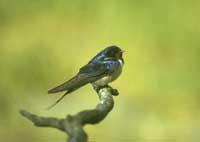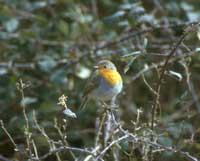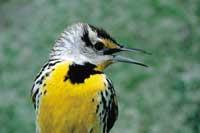How do birds sing?
2002/05/19 Carton Virto, Eider - Elhuyar Zientzia

But don't think this is because biologists are vague. Analyzing the singing of birds is not easy, since the voice organ of birds is not as visible as the human. In mammals the larynx is associated with the nose, but the voice organ of birds, that is, siring, is well kept in the body. Birds do not breathe like mammals. Like the bellows, they have bags of air that drive the air through the lungs, and surrounded by one of them, including the muscular mataza of the side of the heart, is the syrinx in the form of nuts. In addition, it is the size of a small pea. It is understandable, therefore, that it has had so many difficulties to analyze it.
But in the end, after years of effort, they discover the secret of the birds. An endoscope in the throat or in the atmosphere of helium has been placed in the singing, the breathing has been measured and the muscular activity of the throat has been studied. And birds capable of singing have seen that they have a common feature: two voice boxes. The double voice box allows you to do two things at a time, for example, form a duet with yourself.

Birds unable to sing, such as duck, chicken, or parrot, have the syrinx in the trachea just a little higher than the trachea in the bronchi that go to the lungs. The siring of birds with ability to sing is somewhat lower. In this way, the voice organ includes both bronchi.
Taking advantage of the duplicity
The location of the syrinx has prevented its observation for years. Researchers have used indirect approaches such as cutting a muscle and observing its influence on the bird's song. However, difficult methods. Fortunately, about ten years ago, it was invented the way to place a small tool for measuring airflow in the bronchi of birds. Surgery is small for birds and a source of information for researchers. Thanks to this method, we have been able to know in which tube of siring occurs each of the sounds and have found several tricks that use the birds to create complex songs.
Some, through the simultaneous use of the two voices, make duets – they produce a growing note in one of the syrinx tubes and lower in the other. Others use the tubes alternatively, throwing one note after another, quickly and continuously. Many birds use siring as a speaker. The tube on the left is formed in low notes and on the right in high notes. The cardinal, for example, produces a note that goes up gently from one kilohercilla to seven, and that passes right through the left tube around 3.5 kilohertz. But the two siring tubes are equal, both in size and in structure. Apparently, the ability consists in exercising a different force on each side.

The canaries have given a special use to the duplicity of siring, singing on the left while breathing on the right. As the two pouches of lung of the birds are joined together, even breathing on one side, they fill the two bags of lung with air. This division of works allows the canaries to release sequences of songs of 30 "syllables" followed, but also create short sonic segments per second. And so that they are not without air, after each "syllable" they make a quick inspiration. The goal is to achieve speed in singing. And for what? It seems that canarian females prefer males able to sing fast.
From siring to peak
The throat and mouth of the bird have a great influence on the song that will reach our ears. Resonances produced in the throat and mouth can dramatically alter the initial sound. This effect is very evident in the human voice. The gorges, mouths and teeth of the human being are responsible for shaping the vowels and consonants with the tone that makes the voice unique. For the same reason, when we speak in the atmosphere of helium, we have a higher tone of voice than usual. The frequency of the vibration of the vocal cords hardly varies by breathing the helium or breathing the air, but being this lighter than the air, the sound is transported faster and the resonances of tone higher than normal are accentuated.


Something similar happens to birds. Placed in the atmosphere enriched with helium, they emit high frequency tones, similar to the songs of the pigeons. These tones do not appear when birds sing in the aerial atmosphere. In view of this, it was postulated that the ceiling of the beak acts as filter, that is, amplifying the sounds produced by the siring, helps to create pure melodies.
But many birds jump from one octave to another in the song, so they would have to adapt the filter constantly to create the right melody at every moment. The adaptation is done with more or less open peak. By adding high notes, they open the beak more to reduce the mouth and create resonance more frequently. However, there are still many questions to answer, for example, how birds can sing so high.
All these apparently academic researches acquire a new dimension as the voice system of birds is similar to that of human beings. According to some researchers, the study of bird siring allows to learn about the human vocal apparatus.
Published in 7K.

Gai honi buruzko eduki gehiago
Elhuyarrek garatutako teknologia



